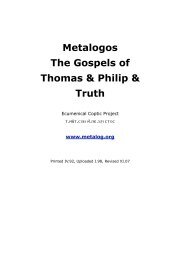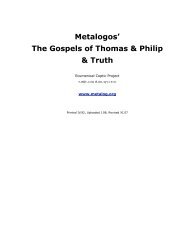Andrew Louth - Syriac Christian Church
Andrew Louth - Syriac Christian Church
Andrew Louth - Syriac Christian Church
Create successful ePaper yourself
Turn your PDF publications into a flip-book with our unique Google optimized e-Paper software.
6 INTRODUCTION<br />
result of an adulterous union between a Samaritan man and a Persian<br />
slave-girl. He was christened Moschion. His father died when he was<br />
nine and his mother a year later. The young Moschion became the<br />
monk Maximus of the monastery of Palaia Lavra, where he was<br />
received by the abbot Pantaleon. This <strong>Syriac</strong> account adds that<br />
Maximus attracted the attention of Sophronius— indeed it gives the<br />
impression that the brilliant younger man influenced the learned<br />
Sophronius—and that the abbot who tonsured Maximus was a ‘wicked<br />
Origenist’. When he published the <strong>Syriac</strong> Life, Brock pointed out the<br />
plausibility of this account of the young Maximus: the Palaia Lavra<br />
was the monastery of St Chariton, not far from the monastery of St<br />
Theodosius where Sophronius was a monk, so the close relationship<br />
with Sophronius was long-standing. Tarring Maximus with the<br />
Origenist brush could be significant, except that the accusation of<br />
‘Origenism’ was hurled about pretty freely in monastic circles. The<br />
important thing about this <strong>Syriac</strong> account is that, unlike the tenthcentury<br />
Greek account, this Life is contemporary with Maximus,<br />
written by one George of Reshaina. Its hostile tone is explained by its<br />
Monothelite provenance: Monothelitism was, as we shall see, the<br />
Christological heresy against which Maximus struggled in the last<br />
decades of his life—a struggle that ultimately cost him his life. Its<br />
concrete details invite credence, and the tone would have perhaps<br />
seemed less hostile to Byzantine ears than it does to ours: according to<br />
his Life, St Theodore of Sykeon was the result of a one-night stand,<br />
and that was not held against him! But although the <strong>Syriac</strong> Life<br />
makes sense of his relationship with Sophronius, it does not explain<br />
Maximus’ apparent easy entrée at the court, nor the evidence of the<br />
considerably greater learning than he could have acquired as a<br />
provincial monk that is found in his writings, especially in the Books<br />
of Difficulties. It does remind us,however, that we have very little firm<br />
evidence for Maximus’ life before his stay in North Africa in the<br />
630s. 11<br />
POLITICAL SITUATION IN THE EARLY<br />
SEVENTH CENTURY<br />
Before we embark on the rest of Maximus’ life, it would perhaps be<br />
useful to fill in more of the detail of the century in which he lived his<br />
adult life. We saw that the later sixth century had seen a long drawnout<br />
war between the Byzantine Empire and Persia. This ended in<br />
Byzantine victory: a revolt in the Persian army led to the overthrow<br />
and death of Shah Hormisdas in 590. His successor Chosroes II fled to<br />
the Byzantine Emperor Maurice for protection. With Maurice’s<br />
assistance, Chosroes defeated the usurper Baram and, having married




